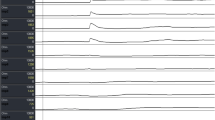Abstract
Seven institutions participated in this small clinical trial that included 19 patients who exhibited oropharyngeal dysphagia on videofluorography (VFG) involving the upper esophageal sphincter (UES) and who had a 3-month history of aspiration. All patients were randomized to either traditional swallowing therapy or the Shaker exercise for 6 weeks. Each patient received a modified barium swallow pre- and post-therapy, including two swallows each of 3 ml and 5 ml liquid barium and 3 ml barium pudding. Each videofluorographic study was sent to a central laboratory and digitized in order to measure hyoid and larynx movement as well as UES opening. Fourteen patients received both pre-and post-therapy VFG studies. There was significantly less aspiration post-therapy in patients in the Shaker group. Residue in the various oral and pharyngeal locations did not differ between the groups. With traditional therapy, there were several significant increases from pre- to post-therapy, including superior laryngeal movement and superior hyoid movement on 3-ml pudding swallows and anterior laryngeal movement on 3-ml liquid boluses, indicating significant improvement in swallowing physiology. After both types of therapy there is a significant increase in UES opening width on 3-ml paste swallows.
Similar content being viewed by others
References
Cook IJ, Dodds WJ, Dantas RO, Massey B, Kern MK, Lang IM, et al. Opening mechanisms of the human upper esophageal sphincter. Am J Physiol. 1989;257(5 Pt 1):G748–59.
Jacob P, Kahrilas PJ, Logemann JA, Shah V, Ha T. Upper esophageal sphincter opening and modulation during swallowing. Gastroenterology. 1989;97(6):1469–78.
Kahrilas PJ, Dodds WJ, Dent J, Logemann JA, Shaker R. Upper esophageal sphincter function during deglutition. Gastroenterology. 1988;95(1):52–62.
Lang IM, Shaker R. An update on the physiology of the components of the upper esophageal sphincter. Dysphagia. 1994;9(4):229–32.
Shaker R, Kern M, Bardan E, Taylor A, Stewart ET, Hoffmann RG, et al. Augmentation of deglutitive upper esophageal sphincter opening in the elderly by exercise. Am J Physiol. 1997;272(6 Pt 1):G1518–22.
Shaker R, Easterling C, Kern M, Nitschke T, Massey B, Daniels S, et al. Rehabilitation of swallowing by exercise in tube-fed patients with pharyngeal dysphagia secondary to abnormal UES opening. Gastroenterology. 2002;122(5):1314–21.
Logemann JA, Pauloski BR, Rademaker AW, Colangelo LA. Super-supraglottic swallow in irradiated head and neck cancer patients. Head Neck. 1998;19(6):535–40.
Martin BJW, Logemann JA, Shaker R, Dodds WJ. Normal laryngeal valving patterns during three breath hold maneuvers: a pilot investigation. Dysphagia. 1993;8:11–20.
Ohmae Y, Logemann JA, Kaiser P, Hanson DG, Kahrilas PJ. Effects of two breath-holding maneuvers on oropharyngeal swallow. Ann Otol Rhinol Laryngol. 1996;105:123–31.
Ohmae Y, Ogura M, Taraho T, Kitahara S, Inouye T. Effects of head rotation on pharyngeal function during normal swallow. Ann Otol Rhinol Laryngol. 1998;107:344–8.
Kahrilas PJ, Logemann JA, Krugler C, Flanagan E. Volitional augmentation of upper esophageal sphincter opening during swallowing. Am J Physiol. 1991;260(3 Pt 1):G450–6.
Lazarus C, Logemann JA, Gibbons P. Effects of maneuvers on swallowing function in a dysphagic oral cancer patient. Head Neck. 1993;15:419–24.
Logemann JA, Kahrilas PJ. Relearning to swallow post CVA: application of maneuvers and indirect biofeedback: a case study. Neurology. 1990;40:1136–8.
Veis S, Logemann JA, Colangelo LA. Effects of three techniques on maximum posterior movement of tongue base. Dysphagia. 2000;15:142–5.
Dodds WJ, Logemann JA, Stewart ET. Radiologic assessment of abnormal oral and pharyngeal phases of swallowing. AJR Am J Roentgenol. 1990;154(5):965–74.
Logemann JA. Evaluation and treatment of swallowing disorders. 2nd ed. Austin, TX: Pro-Ed; 1998.
Logemann JA. A manual for videofluoroscopic evaluation of swallowing, 2nd ed. Austin, TX: Pro-Ed; 1993.
List MA, Ritter-Sterr C, Lansky SB. A performance status for head and neck cancer patients. Cancer. 1990;66:564–9.
Easterling C, Grande B, Kern M, Sears K, Shaker R. Attaining and maintaining isometric and isokinetic goals of the Shaker exercise. Dysphagia. 2005;20:133–8.
Reimers-Neils L, Logemann JA, Larson C. Viscosity effects on EMG activity in normal swallow. Dysphagia. 1994;9:101–6.
Author information
Authors and Affiliations
Corresponding author
Rights and permissions
About this article
Cite this article
Logemann, J.A., Rademaker, A., Pauloski, B.R. et al. A Randomized Study Comparing the Shaker Exercise with Traditional Therapy: A Preliminary Study. Dysphagia 24, 403–411 (2009). https://doi.org/10.1007/s00455-009-9217-0
Received:
Accepted:
Published:
Issue Date:
DOI: https://doi.org/10.1007/s00455-009-9217-0




